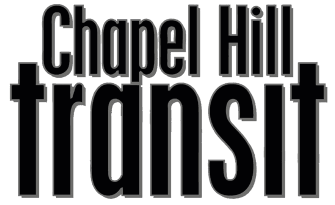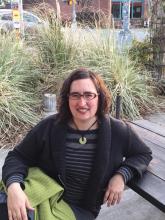
Fare-free transit service is a key amenity in our community. As a result of the Orange County Bus and Rail Investment Plan that Orange County voters passed in 2012, we are seeing improvements to our service with more to come. We ask Brian Litchfield, Chapel Hill Transit Director, some questions about those improvements and other issues surrounding transit in our community. Take a look and then share what you would like to see.
Q & A With Brian Litchfield, Director of Chapel Hill Transit
Thank you for this opportunity and I appreciate you sharing information about some of the initiatives Chapel Hill Transit currently has underway via OrangePolitics. First, let me offer a quick overview of Chapel Hill Transit.
Chapel Hill Transit, the second largest transit system in North Carolina, is a partnership between the Town of Chapel Hill, Town of Carrboro and the University of North Carolina at Chapel Hill. We provide fixed-route bus services (32 weekday & weekend routes) and EZ Rider (ADA Paratransit) services. Chapel Hill Transit has a fleet of 118 vehicles (99 fixed-route and 19 demand response) - providing almost 7 million annual customer rides and covering over 2.5 million miles. Additional information about our services is available at www.chtransit.org
In November 2012, Orange County voters approved a referendum that provides funds to improve transit service, including Chapel Hill Transit service. What improvements has Chapel Hill Transit already made with those funds, and what improvements are you planning with next year's allocation?
We are excited about being able to begin implementing the Orange County Bus and Rail Investment Plan, along with Triangle Transit and Orange County. In the current fiscal year, we'll receive around $470,000 from the plan. Some of those funds will be utilized to help cover the increased cost of existing services not covered by the Chapel Hill Transit funding partners (Town of Chapel Hill, Town of Carrboro and University of North Carolina at Chapel Hill) increased contributions and to implement the following service improvements designed to provide improved access to jobs with non-traditional work hours and expand access to retail, medical, recreational and education destinations in Chapel Hill and Carrboro for lower-income and transit dependent residents:
- Weekday: CM, CW, D, F and J (later evening service now operates year around on these routes and additional trips were added to the F)
- Weekend: CM, CW and JN (CM and CW now operates as separate routes and an additional AM trip was added to the JN).
- implement service improvements, such as evening/nighttime and weekend service, that would provide improved access to jobs with nontraditional work hours
- expand access to retail, medical, recreational and education
destinations in Chapel Hill and Carrboro for lower-income and transit dependent
residents
- identified areas of interest include better serving the Rogers Road community and other lower-income populations.
- meet peak-hour service demands (e.g. overcrowding, lack of service, etc.)
- cover cost of existing services
Over the next several years, additional service improvements and new services are planned for Chapel Hill Transit, Orange Public Transportation, and Triangle Transit as part of this plan. Residents will also likely see new bus shelters, park-and-ride lots and sidewalk connections to bus stops.
Will there ever be Sunday service?
That's a great question, and one that I ask myself because it would be truly wonderful for the communities we serve -- but, honestly, I do not know the answer. For many years Sunday Service has been one of the most requested services by our residents and customers. As I spend time talking with customers and organizations that rely on Chapel Hill Transit (And, as a regular rider) I understand the needs - Sunday service would likely make it possible and more convenient for the residents to get to worship services, jobs, medical facilities, shopping centers and other destinations not currently accessible on Sundays by Chapel Hill Transit - in addition to making connections regionally, as Triangle Transit explores the option of Sunday service in our area. Our strategic and financial planning process, which I'll talk about more a little later, reviews and works to balance many requests for services with limited resources. In the spirit of thinking about the Chapel Hill Transit Budget as an expression of our community's values and aspirations, I would put that question back to our customers and the community.
We have heard from residents that some bus shelters need improvements and some bus stops need bus shelters. Does Chapel Hill Transit have plans for bus shelter improvements?
The public's first impression of Chapel Hill Transit and our services is the bus stop. It is important that our stops are easily identifiable, safe, accessible, and a comfortable place for customers to wait for the bus. While it is likely that we will always have underdeveloped bus stops, we feel that it is important to begin taking steps to improve our bus stops and our customers' experience while waiting for the bus. We also feel that our bus stops and shelters in particular, in addition to providing a safe and attractive waiting place for our customers, should also make a positive contribution to the streetscapes in the areas we serve.
A little over two years ago, Chapel Hill Transit undertook a bus stop/shelter assessment project and due to other significant priorities little progress has been made to begin addressing the issues identified by the assessment. We currently have 120 shelters located at 100 stop locations (some locations have more than one shelter) in our service area. Many of these existing shelters are beginning to age, at least 10 are in a total state of disrepair, many do not include lighting or basic amenities such as a bench or map holder and several do not meet Americans with Disabilities Act (ADA) requirements due to their design. We are committing funding to bus stop and shelter improvements next year and we are also starting with making some small improvements this year - our focus will be on bringing stops up to ADA standards and eliminating safety concerns. We are also working with our funding partners to identify a more modern style shelter(s) that can incorporate solar panels, as well as LED lighting options and other passenger amenities (e.g. next bus signs, trash cans, benches, system maps, etc.).
What are the goals of the North-South Corridor Study?
Chapel Hill Transit has launched the North-South Corridor Study, a transit service planning initiative for the corridor linking Martin Luther King Jr. Boulevard, South Columbia Street and US Highway 15-501 South. The North-South Corridor study will review the transportation corridor from the Eubanks Road Park and Ride to the Southern Village Park and Ride Lot. Its purpose is to identify and evaluate improved accessibility, capacity, convenience and travel-time for riders. Safety and pedestrian activities, future development potential, and impacts to existing neighborhoods will be paramount concerns of the study. The study will examine a variety of public transportation options and alignments and will conclude with the identification of a Locally Preferred Alternative (LPA) for the corridor. The study is funded by a grant from the Federal Transit Administration (FTA) and the Chapel Hill Transit funding partners. Service expansions/improvements identified by the study may be funded by the Orange County Bus and Rail Investment Plan.
The North-South Corridor study represents a significant step towards achieving the goals established by the Chapel Hill 2020 comprehensive plan. The comprehensive planning work was conducted in six theme groups. "Getting Around" theme group established a set of goals aimed at the development of a well-balanced and holistic transportation system that connects communities, provides a variety of transportation options and places an emphasis on ecological consciousness.
We held a couple of public involvement opportunities for the study in March and additional public involvement opportunities will be announced in the near future. Additional project information is available at the North-South Corridor Study website: www.NSCStudy.org.
What is the status of the Chapel Hill Transit bus fleet? Will we need more buses in the near future? How will they be paid for?
Chapel Hill Transit's fleet of 99 fixed-route vehicles includes 42 heavy-duty transit buses and 19 demand response (EZ Rider) vehicles that are beyond their useful life as defined by Federal Transit Administration (FTA) guidelines. Chapel Hill Transit has initiated a study with our funding partners to develop a strategic vision and financial plan for the transit system. The study will accomplish the following:
- Develop a strategic plan for CHT based on the Town's recently adopted Comprehensive Plan, established planning documents and public input.
- Create a sustainable financial plan to support the strategic plan.
- Recommend changes to the operation, organization and support systems to improve efficiency and effectiveness.
Additional information on the study is available at: http://www.chtstrategicplan.com/
There may also be funding options for some buses through the Orange County Bus and Rail Investment Plan and we are also pursuing grant funding opportunities, as they become available at the state and federal level.
There has been much news coverage about overcrowding on certain bus routes, especially at peak times. What is a realistic timeline for Chapel Hill Transit riders to expect overcrowding issues to be addressed?
We
continually monitor customer demand on all trips, especially our peak hour
services. If an Operator's bus becomes overloaded, our procedure
requires he or she to contact a dispatcher. The dispatcher will put an extra
bus on that route, if equipment is available. Standing loads are
fairly common on Chapel Hill Transit routes, especially during peak
hours. As a regular rider, I
understand customer concerns with full buses.
It is unsafe for both the customers and the Operator to be in a bus that is too
full. While it is awful to be the customer left at a stop, it is equally
unpleasant to be squished onboard. Buses are designed for many people to stand,
but there are limits. Operators also suffer with reduced visibility when this
occurs and it is unsafe for an Operator to not be able to see out of all
mirrors. The Operator makes the call on over capacity. A guide all
Operators use is the yellow standee line on the floor of the bus, which is just
behind the Operator's seat. If customers are stepping over this line, then the
bus is definitely at capacity and it is unsafe for the Operator to proceed. We also encourage customers
boarding at park and ride locations to arrive at their stop 5-10
minutes before the scheduled departure time - this may help
ensure access to a seat on trips with high demand.
Staff has recommended that the Partners utilize some portion of the funding we'll likely receive from the Orange County Bus and Rail Investment Plan this year to assist with providing additional peak hour service on our highest demand routes. The Partners will make a recommendation to the Chapel Hill Town Council related to the utilization of these funds as part of our FY15 budget submission.
There has also been some (inaccurate) reporting about the potential for Chapel Hill Transit to do away with the fare-free model. Can you talk about how the fare-free model has worked in Chapel Hill and its long-term sustainability?
The Chapel Hill Transit funding partners (Town of Chapel Hill, Town of Carrboro and University of North Carolina at Chapel Hill) are committed to providing fare-free transportation. We'll evaluate the fare-free service as part of the strategic and financial plan I mentioned earlier to assure that not only is it sustainable but that it continues to make sense for our partners. We've had incredible success with the fare-free system over the last decade, and our sense is that this success will continue into the future.
Issues:


